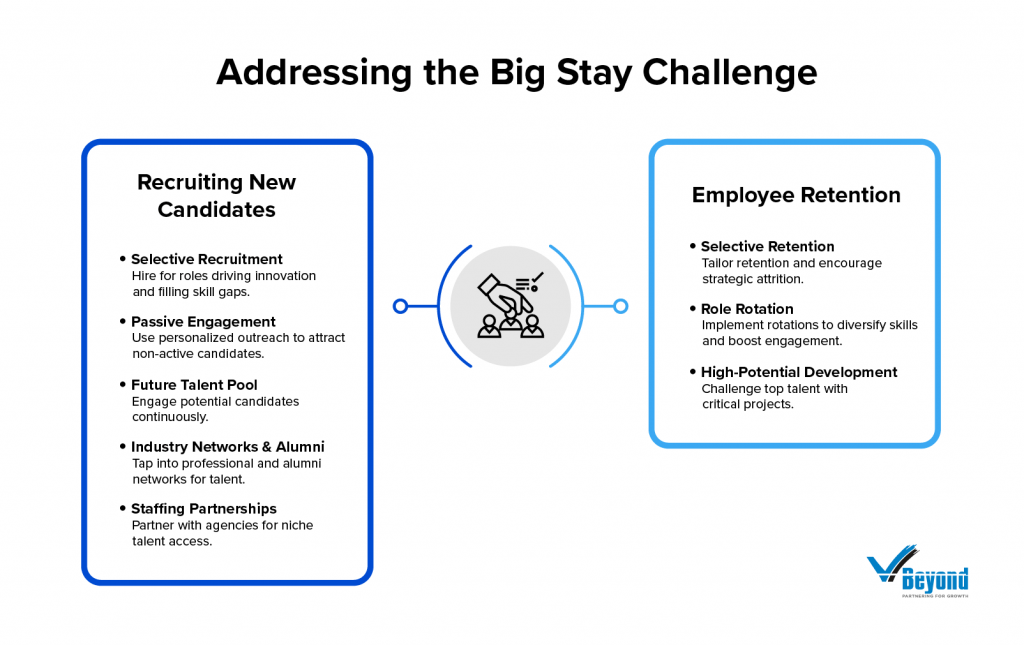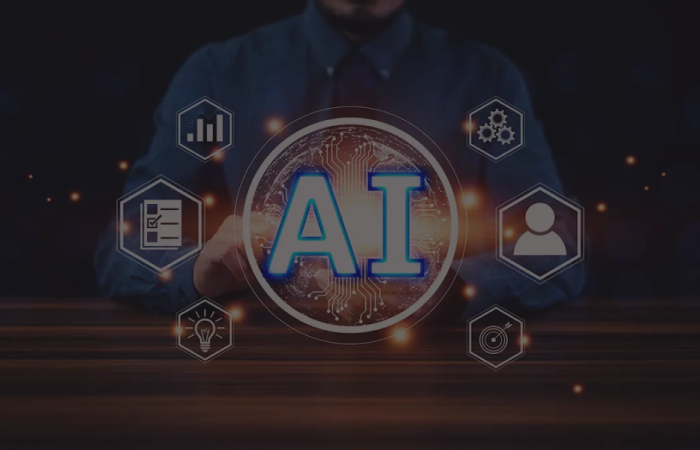In recent years, the workforce has undergone significant changes, from the upheaval of the pandemic to the mass exodus during the Great Reshuffle. Now, we are witnessing what many call the “Big Stay,” a period characterized by a marked decline in employee departures. LinkedIn Insights data shows a 26% year-over-year drop in attrition rates, suggesting that employees are staying put longer than before.
However, the permanence of this trend remains uncertain. Is the Big Stay here to stay, or is it just a temporary phase before the next shift in the labor market? Understanding these dynamics is crucial for strategic talent management. In this blog, we will explore five key strategies that can help organizations effectively address the challenges and opportunities presented by the Big Stay.
The Big Stay Unveiled: Understanding the New Workforce Reality
Globally, the “Big Stay” is emerging as a significant trend in the workforce, marked by a sharp decline in employee attrition rates. According to LinkedIn Insights, the decrease indicates that employees are choosing stability over the volatility of job changes. This trend spans various industries, from healthcare to retail, and reflects a broader shift in employee behavior following the tumultuous period of the Great Reshuffle. As companies adjust to the new reality, they face recruitment challenges and the need for effective talent retention strategies. Balancing these elements is crucial for maintaining workforce stability in a landscape where talent is less likely to move.
In the UK, for instance, the Big Stay is particularly evident, driven by growing concerns over job security. As per a latest article by HRnews, UK-based news service, 71% of professionals in the country are staying with their current employers due to fears surrounding job stability. The uncertain economic climate, marked by inflation and fluctuating unemployment rates, has made job security a top priority for many workers. Consequently, UK professionals are increasingly hesitant to pursue new opportunities, with many opting to remain in their current roles despite potential career stagnation. This regional perspective underscores the unique factors influencing the Big Stay in different markets.
When considered together, the global and UK-specific insights reveal a complex picture of the Big Stay. While the trend provides a period of stability for both employees and organizations, it also presents challenges in terms of talent mobility and growth. As companies across the globe grapple with these dynamics, it becomes essential to rethink and refine effective recruitment strategies. The following section will explore five key recruitment strategies that organizations can employ to effectively address the recruitment challenges and opportunities presented by the Big Stay.
Mastering the Big Stay: Tackling the Twin Challenges of Workforce Stability and Innovation
The Big Stay, as indicated above, presents organizations with a unique challenge: while low attrition rates offer stability, they also limit opportunities to bring in fresh talent. To thrive in this environment, companies must strike a balance between strategically attracting new candidates and maximizing the potential of their existing workforce. Organizations need to remain competitive, innovative, and prepared for future shifts in the labor market through strategic talent management and by addressing talent management challenges effectively.
1. Winning the Talent Game: Smart Recruitment Strategies in a Stay-Driven Market
A. Selective Recruitment for Strategic Roles
In a low-attrition environment, the dynamics of recruitment shift significantly. With fewer employees leaving, organizations face less pressure to fill vacancies quickly, allowing them to be far more strategic about the roles they choose to open. This scenario presents a unique opportunity to pivot from reactive hiring to a more calculated approach, where every new hire is viewed as a critical investment in the organization’s future. By focusing on recruiting for strategic roles—those that drive innovation, address critical skill gaps, or spearhead new business initiatives—organizations can ensure that each addition to the team brings disproportionate value. This not only aligns with long-term goals but also fortifies the company’s competitive edge.
To maximize the impact of this approach, it’s essential to conduct a thorough internal audit to identify these critical roles. This isn’t just about filling current gaps, but also anticipating future needs as the industry evolves. Job descriptions should be meticulously crafted, highlighting the strategic importance of the role and its potential impact on the company’s growth trajectory. Furthermore, incorporating both behavioral and technical assessments into the recruitment process allows organizations to evaluate candidates not only on their current competencies but also on their potential to drive future growth. This method ensures that every new hire is not just a good fit for the present but is poised to propel the organization forward in the long term.
B. Passive Candidate Engagement with Personalized Outreach
In the context of the Big Stay, where employees are less likely to actively seek new opportunities, the traditional methods of recruitment may fall short. This is where the concept of passive candidate engagement becomes crucial. Passive candidates—those who are currently employed and not actively looking to change jobs—represent a vast reservoir of untapped talent. Engaging these individuals requires a shift from broad, generic outreach to highly personalized and strategic communication. By understanding the unique career aspirations and motivations of these candidates, organizations can craft messages that resonate deeply, offering them compelling reasons to consider a move.
The relevance of this approach in a low-attrition environment cannot be overstated. With fewer people on the market, the competition for top talent intensifies. Using data analytics, companies can identify passive candidates who align with their strategic needs and who may be swayed by the right opportunity. Personalized outreach campaigns, tailored to the individual’s professional journey and future goals, can turn a passive interest into active consideration. Moreover, engaging these candidates through multiple channels—be it LinkedIn, industry forums, or personal networking events—ensures that your organization remains visible and attractive, even to those who aren’t actively looking. This strategy not only broadens your talent pool but also ensures that you are always one step ahead in securing the best talent.
C. Creating a Future-Focused Talent Pool
In an environment where employees are staying put, it’s easy for organizations to fall into the trap of short-term thinking, focusing solely on immediate hiring needs. However, the Big Stay presents a unique opportunity to think ahead by building a future-focused talent pool. This isn’t just about having a list of potential candidates; it’s about actively engaging with them, nurturing relationships over time, and positioning your organization as their next logical career step when the right opportunity arises. By doing so, companies can ensure that they are not caught off guard when a critical role suddenly needs to be filled.
The key to this approach lies in proactive engagement. Hosting industry events and webinars allows potential candidates to interact with your organization in a low-pressure environment, giving them insight into your company’s culture and vision. Regular communication, such as updates on your company’s successes and future plans, keeps these candidates engaged and interested. Furthermore, offering professional development opportunities—such as exclusive training programs—can deepen their connection to your organization, making them more likely to consider a role when it becomes available. This strategy not only prepares you for future hiring needs but also builds a robust pipeline of talent that is already familiar with and interested in your organization.
D. Leveraging Industry Networks and Alumni for Strategic Hires
In a low-attrition environment, traditional recruitment channels may not yield the desired results. This is where leveraging industry networks and alumni becomes a game-changer. Industry-specific networks and professional associations are rich sources of talent, especially for roles requiring specialized knowledge or experience. These connections often lead to high-quality candidates who are not only well-versed in industry trends but also bring a fresh perspective to the organization. Additionally, alumni networks provide a pool of candidates who already understand your company’s culture and can reintegrate smoothly, making them ideal for strategic hires.
The logic behind this approach is clear: when attrition is low, and the talent market is tight, leveraging established relationships becomes crucial. Engaging with professional associations allows your organization to stay at the forefront of industry developments while also identifying emerging leaders who may be the perfect fit for your strategic roles. Reconnecting with alumni, through newsletters, events, or direct outreach, helps maintain a strong relationship with former employees who may be looking for a return to familiar grounds under new circumstances. Additionally, encouraging employee referrals taps into your current workforce’s networks, ensuring that you are accessing a wider, yet highly vetted, talent pool. These strategies collectively enhance your ability to make strategic hires, even when the external market is less dynamic.
E. Partnering with Staffing and Recruitment Services Providers
In a low-attrition environment, where the immediate need for recruitment might be less obvious, partnering with specialized staffing and recruitment services providers can still be a strategic move. These providers offer access to niche talent pools, particularly for highly specialized roles that are critical to the organization’s growth or innovation strategies. Additionally, they provide a safety net by maintaining a talent pipeline that can be tapped into when unplanned attrition or strategic opportunities arise.
The value of this partnership lies in the providers’ ability to extend your organization’s reach and expertise in identifying and attracting top-tier talent. By working closely with a recruitment firm, your organization can ensure that it is always prepared to fill critical roles swiftly and effectively, even when internal recruitment resources are focused on other priorities. This collaboration not only supports strategic growth but also ensures that your company remains agile and competitive, regardless of the current attrition landscape.
2. Retention Reimagined: Crafting Dynamic Employee Experiences Amid Workforce Stability
A. Differentiated Retention and Selective Attrition Strategies Based on Employee Segmentation
In a low-attrition environment, it’s crucial to assess whether the stability your workforce is experiencing is beneficial or leading to stagnation. Stability can enhance efficiency and team dynamics, but it may also result in complacency and a lack of innovation.
To address this, segment your workforce based on factors like career stage, skill relevance, and future potential. This segmentation allows for tailored retention strategies that cater to the unique needs of different employee groups, ensuring that critical talent remains engaged and motivated.
For high-performers and those with high potential, focus on offering career development opportunities and recognition programs to keep them invested in the company’s future. Conversely, for employees whose roles no longer align with strategic goals or who may benefit from new challenges, consider encouraging selective attrition. This can be achieved by offering voluntary separation packages or facilitating lateral moves within the company.
Selective attrition is a strategic tool that allows for the introduction of fresh perspectives and skills, helping to prevent stagnation. By balancing the retention of key talent with opportunities for new hires, your organization can maintain a dynamic and adaptable workforce, ready to meet future challenges.
Regularly assess your workforce and implement tailored retention programs while encouraging a culture of continuous learning and development. This approach ensures that your organization remains innovative and competitive, even as the external labor market shifts.
B. Proactive Role Rotation and Cross-Functional Exposure
In a low-attrition environment, the challenge lies in leveraging stability to fuel innovation rather than allowing it to breed complacency. The goal is to go beyond merely retaining employees, focusing instead on enhancing the value they bring to ensure that the workforce remains a dynamic and evolving asset.
One effective approach is to introduce structured role rotation programs that give employees the opportunity to work in different departments. This not only diversifies their skills and breaks down internal silos but also keeps the workforce engaged and ensures that critical knowledge circulates throughout the organization, strengthening overall resilience.
To complement this, establish cross-functional project teams where employees from various departments collaborate on strategic initiatives. This setup exposes employees to different facets of the business, bringing fresh perspectives to problem-solving and inspiring innovative thinking. Additionally, offering temporary assignments in different roles or locations can reignite employees’ passion, broaden their professional horizons, and provide valuable experience that contributes to both personal and organizational growth.
Integrate AI-powered tools to create personalized development paths for employees, ensuring their growth is aligned with both personal aspirations and company goals. Use AI to analyze individual performance and suggest targeted learning opportunities or new project assignments that keep employees engaged. Additionally, AI can predict when an employee might benefit from a change, allowing managers to proactively offer new challenges.
C. Strategic Development of High-Potential Talent Pools
A low attrition environment means organizations have the opportunity to deeply invest in their high-potential employees, as they are likely to stay longer and contribute more. The stability allows for the creation of development pathways that challenge these individuals with complex, real-world problems, preparing them for future leadership roles.
One effective approach is to immerse these individuals in “Strategic Stretch Assignments”—critical, high-stakes projects that push their boundaries and expose them to new challenges. These assignments are not merely about managing existing operations but involve leading initiatives that are pivotal to the company’s growth, such as entering new markets or launching groundbreaking products.
Another key strategy is to establish “Rotational Executive Shadowing”, where high-potential employees spend significant time with members of the senior leadership team. Unlike traditional mentorship, this program allows them to experience firsthand the complexities of executive decision-making across various functions. By rotating through different leadership roles, they gain a comprehensive understanding of the business and develop a holistic perspective that is essential for future leaders. This exposure also allows them to build relationships with key stakeholders and prepares them to step into critical roles with a deep understanding of the organization’s strategic direction.
Lastly, integrate “Future-Focused Leadership Labs”, a visionary exercise where high-potential talent is tasked with exploring emerging trends and technologies that could impact the organization in the next five to ten years. These labs operate as think tanks within the company, encouraging employees to engage in forward-thinking projects that anticipate future disruptions. This not only sharpens their strategic foresight but also ensures that the organization is proactively positioning itself for future success.

Potential Challenges: Navigating the Risks of Stability
As organizations embrace the Big Stay, they must be wary of the hidden risks that accompany workforce stability. One major concern is the potential for complacency among long-tenured employees. Without the infusion of new talent and ideas, companies may inadvertently foster an environment where innovation stalls and growth plateaus. To avoid this, it’s crucial to cultivate a culture of continuous learning, where even the most experienced team members are motivated to expand their skill sets and embrace fresh perspectives.
Another pitfall to consider is the delicate balance between encouraging selective attrition and retaining indispensable talent. While promoting role rotations or offering voluntary separation packages can refresh the workforce, it also carries the risk of losing key employees whose contributions are vital to the organization’s success. Navigating this challenge requires a nuanced approach, leveraging data-driven insights to distinguish between roles that would benefit from new blood and those where stability is essential. Striking this balance is critical to maintaining a dynamic and resilient workforce.
Conclusion: Preparing for the Next Big Wave
The Big Stay is just one chapter in the evolving story of the modern workforce, and the future promises even more change. As remote work entrenches itself in the corporate world, the focus will shift from simply retaining employees to ensuring workforce stability and keeping them engaged and productive, regardless of their physical location. This transition will necessitate innovative recruitment strategies and strategic talent management approaches, as companies strive to maintain a cohesive and motivated team across diverse geographies.
Looking further ahead, the Big Stay might pave the way for a “Big Shift,” where employees increasingly seek roles that resonate with their personal values and long-term aspirations. Organizations that proactively adapt to these emerging trends—by offering purpose-driven work, meaningful career development, and staying at the forefront of technological advancements—will be better equipped to attract and retain top talent. By preparing now for these potential shifts (and thereby recruitment challenges) and adopting innovative talent retention strategies, companies can ensure they remain competitive and resilient in an ever-changing labor market.
Elevate your talent strategy with our expert recruitment services.
Connect with us today to navigate the Big Stay and secure top-tier talent for your organization.


